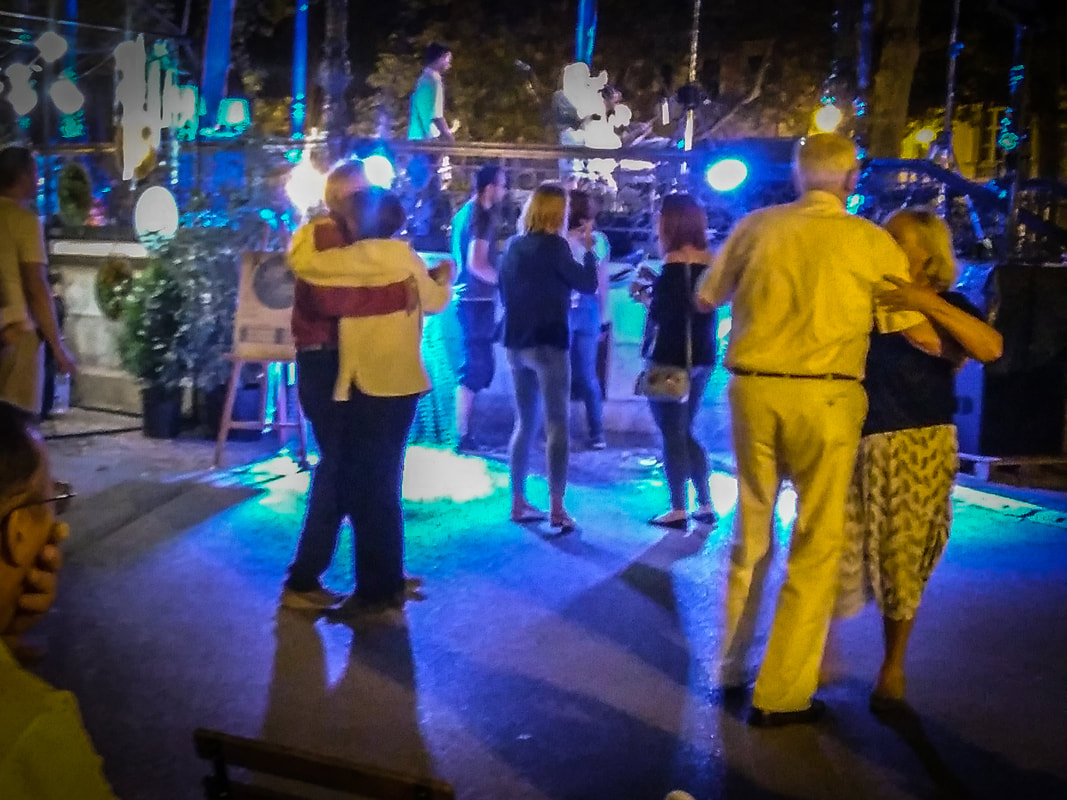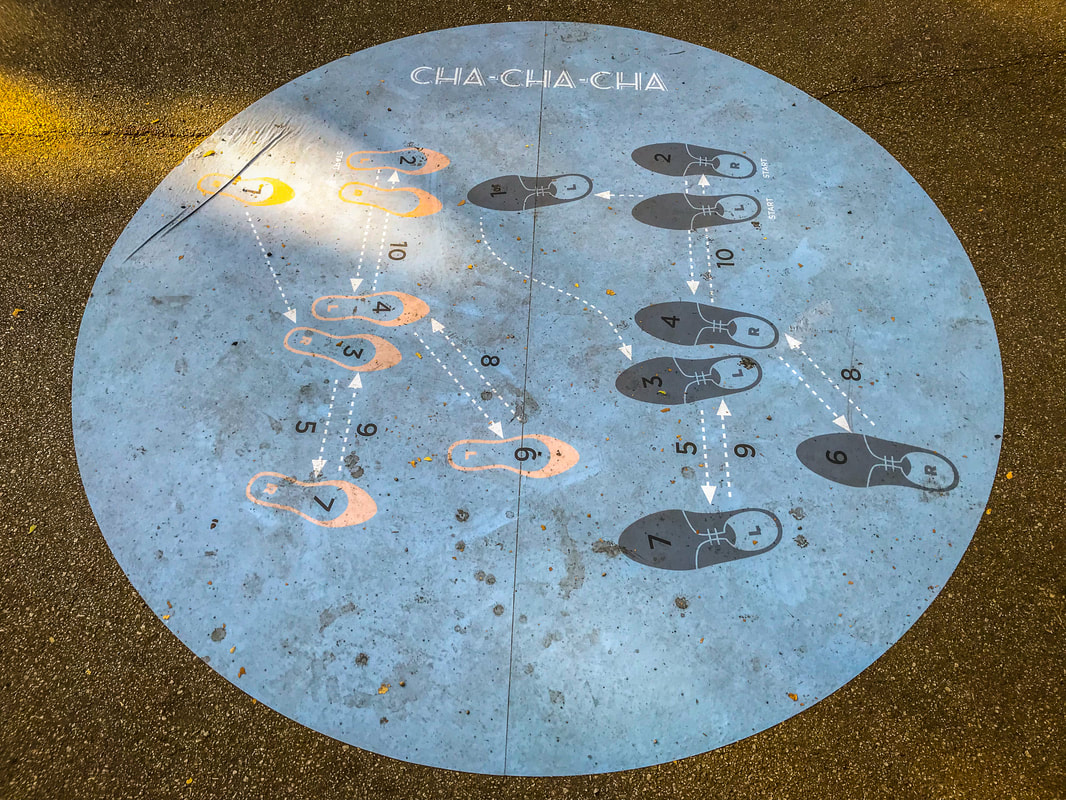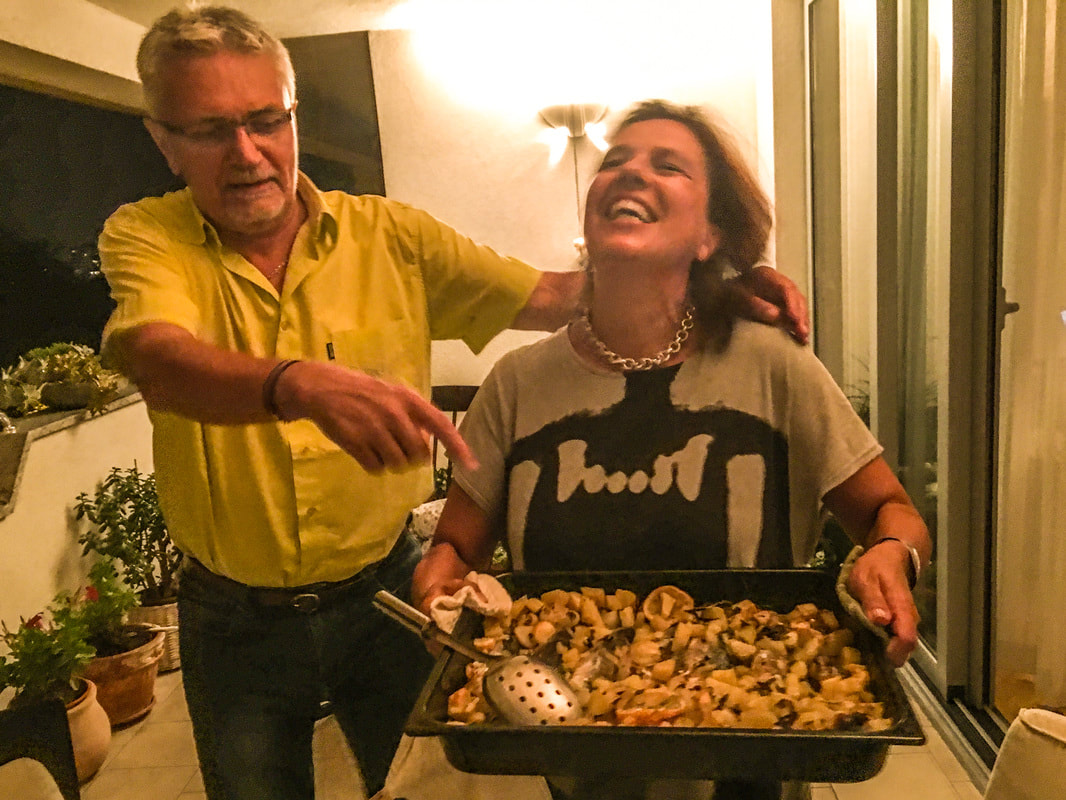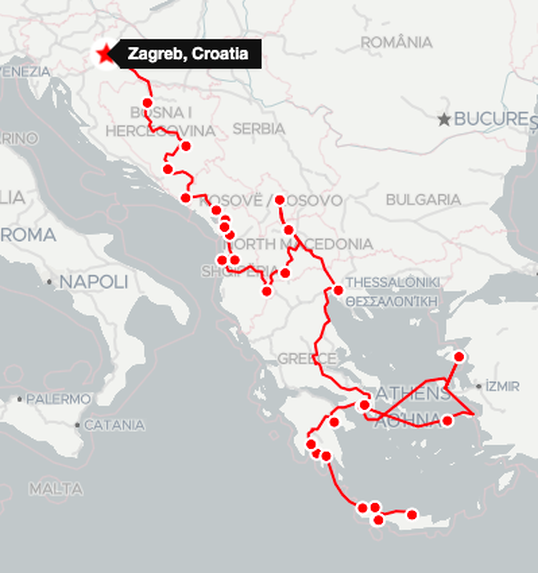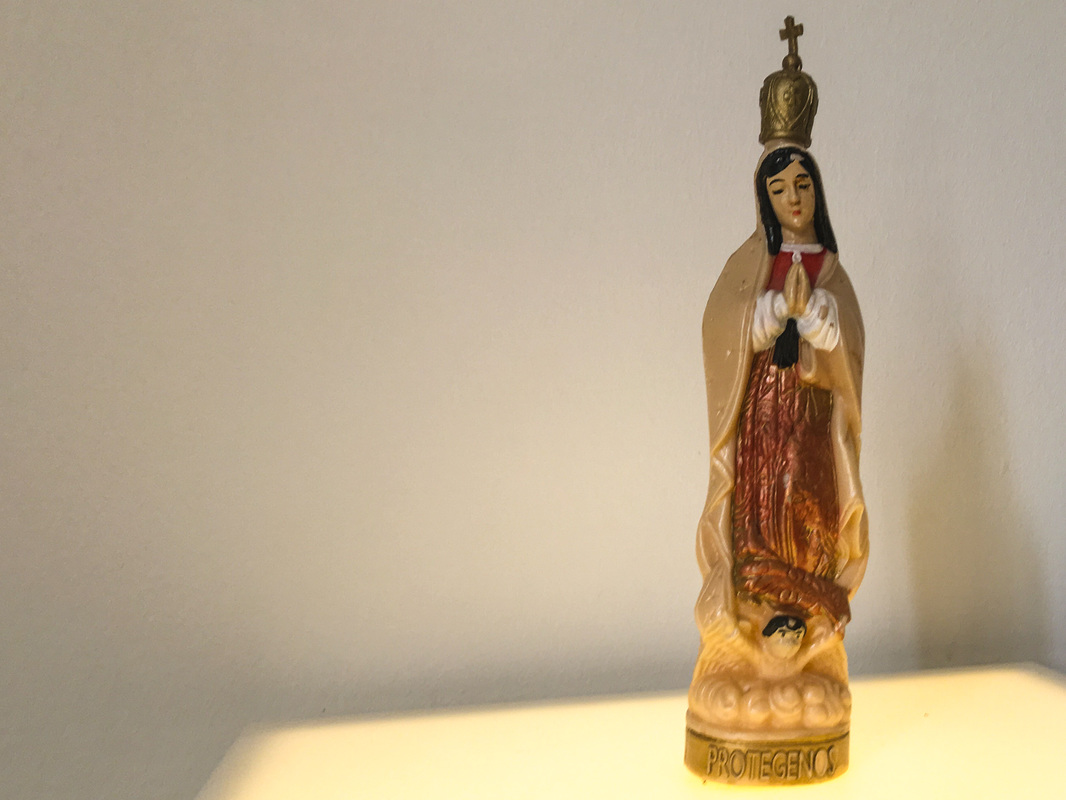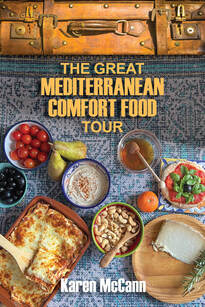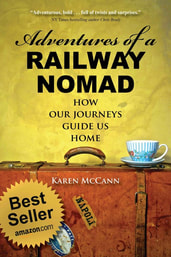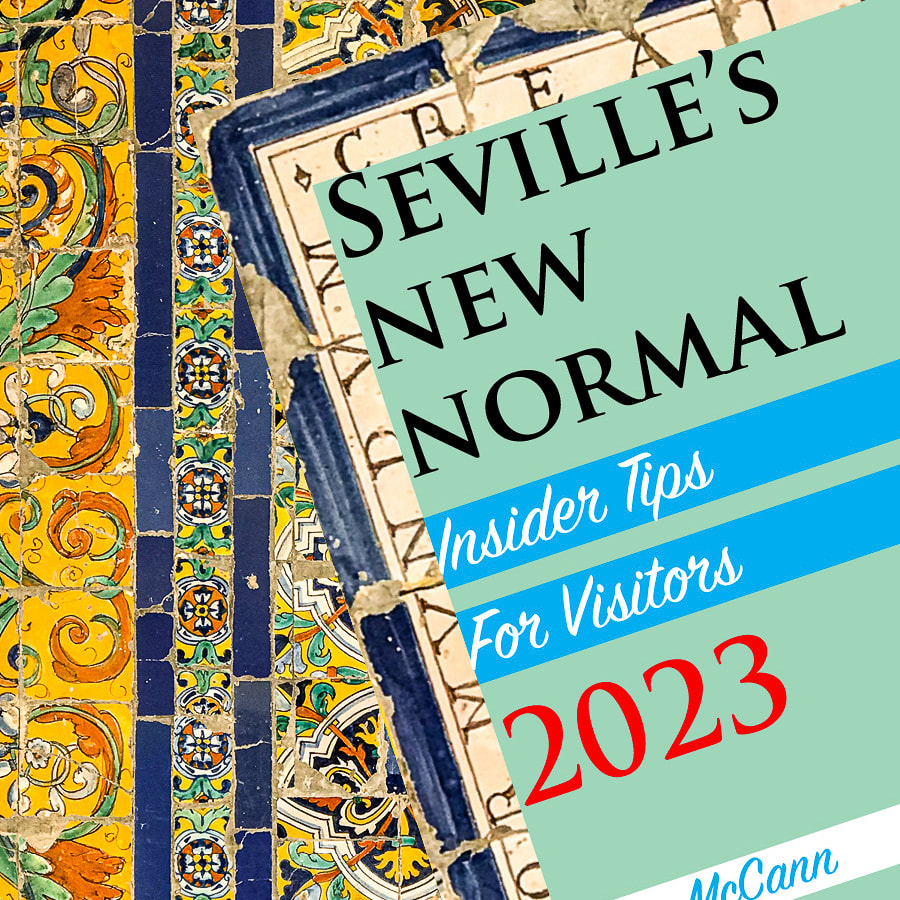|
Remember the chicken dance? The one where you flap your wings and shake your tail feathers? When was the last time you did it walking down the street in a foreign city? Yeah, I can’t remember either; maybe never — until last Monday night in Zagreb, Croatia. That’s when Rich and I heard the chicken dance song coming from the bandstand in Zrinjevac Park and found it too infectious to resist. Fortunately for what remains of my dignity, we weren’t the only ones flapping wings and shaking tail feathers down the sidewalk, under the amused gazes of passing drivers and fellow pedestrians. We hurried toward the bandstand, coming to roost just as the tune ended. No matter. There’s music every night this week and next, mostly foot-taping golden oldies like the Drifters’ “Under the Boardwalk” and I-love-this-one heartwarmers like Louis Armstrong’s What a Wonderful World. The first time we went, Rich and I settled at one of the tiny wooden tables placed around the bandstand and looked around at the small crowd. On a nearby lawn, kids were chasing each other through the twilight, jugglers were practicing under the trees, and women on park benches were languidly cooling their faces with paper fans. Beneath the lights strung in the branches overhead, people were dancing. And pretty soon, we were too. “It feels like Hometown, USA,” I said to Rich. “It’s like the best part of every summer I can remember.” That nostalgia was precisely what city officials were trying to spark when they started the Zagreb Time Machine project, which for many years has sponsored summer dances, street theater, and other public entertainments designed to “bring the romantic spirit of past times to life.” I’d somehow missed all the other activities but fell instantly in love with the Dance Evenings. Zagreb’s Time Machine is set to the mid-20th century, but local history dates back a great deal farther than that. The city was founded in Roman times, expanded during the medieval and industrial eras, survived Nazi occupation, became an economic powerhouse in the former Yugoslavia, and today serves as the capital of independent Croatia — to mention but a few highlights. Through all the changes, one thing has proved constant: this is a city that loves its comfort food. When Rich and I reconnected with Lidija and Mladen, Croatian friends we’d met during an EatWith dinner during our 2016 visit to the city, we told them about our Mediterranean Comfort Food Tour. They instantly responded with a flood of suggestions about what we should be eating while we’re in town. "Strukli, of course," Lidija mused aloud. "And mlinci. Have you tried deer goulash? The best place to find such dishes is Zagorje." Setting off in Mladen's car, we soon found ourselves on the winding roads of Zagorje, a rural area north of Zagreb that needed no government-funded entertainments to give the impression we'd traveled backward in time. Around each curve we discovered families raising cows, grapes, and corn on small farms in sleepy valleys presided over by Medieval castles. “This was the center of the Peasant Revolution of 1573. It all started right here,” Lidija told me. “The nobility demanded that each family contribute food to them. People were living on the edge of hunger, but the lord had an army, and they had to pay. Like today we are forced to pay taxes. So the peasants staged a revolt. It lasted only 12 days. And they took the leader of the rebellion, Matija Gubec, and said to him, ‘You wanted to be king. Here is your crown.’ And they put upon his head an iron crown that was heated red-hot in the fire.” Yikes! “And then they tore him into four pieces.” Quadruple yikes! Gubec became a folk hero, inspiring various political movements, the first Croatian rock opera, and Josip Broz Tito, who was born in a humble Zagorje farmhouse and went on to become president of Yugoslavia. As you can imagine, Zagorje’s cuisine is designed to fortify hard-working agricultural families attempting to subsist on what’s left after the powerful have taken the lion’s share of everything produced on the land. Traditional fare is hearty, made from fresh, inexpensive local ingredients, and bristling with the fats and carbs you’d need for long hours of physical labor. Not exactly health food, but it is a glorious indulgence you’ll never regret. “Here we will eat štrukli,” said Lidija, pulling up at a 1938 country inn called Villa Zelenjak Ventek. When the staff learned this was to be our first tasting of štrukli, Dora, a young, English-speaking manager, arrived to tell us about the treat in store. It seems you make a basic dough, roll it so thin that it completely covers the tabletop, stuff it with a mix of cottage cheese, eggs, sour cream, and salt, and bake it into a sort of cheese strudel. Dora kindly shared photos and the recipe, so that I could pass the legendary dish on to my readers. [See štrukli recipe and photos here.] After lunch, we worked off a few calories strolling around Kumrovec, a charming village of restored nineteenth-century homes centered around Tito’s birthplace and a museum honoring his legacy. While many regarded him as a ruthless dictator, others look back with what’s now known as “Yugonostalgia,” fond memories of simpler times when everyone had a job, a place to live, and enough to eat. “Were you better off then?” I asked Lidija. “In many ways, yes,” she said, with a philosophical shrug. “Things are much harder for us now.” Our final stop of the day was Gresna Gorica, a rustic restaurant nestled in vineyards below the fairytale towers of Veliki Tabor castle. Sitting outside among the vines, we sampled lard laced with bacon, cottage cheese topped with crème fraiche, deer goulash, beans drizzled with pumpkin seed oil, and duck served over something called mlinci, a mysterious dish that appeared to be pasta but inexplicably wasn’t. I may have been a bit muddled by the staggering heat and the natural exhaustion following a day’s vigorous sightseeing, but I simply couldn’t seem to grasp Lidija’s explanation of how mlinci is prepared. It’s a kind of bread and you boil it? Really? “Come to my house and I will make it for you,” Lidija said. “Then you will see how it works.” How good was it? It was so yummy Rich and I started doing the chicken dance right there at the dinner table. Luckily our Croatian friends were familiar with this silly tradition, so they didn’t think we were completely insane. (Or if they did, they were too polite to say so.) We all stuffed ourselves and then sat for a long time, blissfully picking over the remains of the mlinci. [Get mlinci recipe here.] “One thing is clear,” I said to Rich said on the way home. “If we’re going to keep eating like this, we’re going to have to do the chicken dance a lot more often.” Rich just made happy clucking sounds and kept on walking. See all posts about the Mediterranean Comfort Food Tour. See all recipes and videos. Don't miss a single loony adventure or the next mouthwatering recipe. Sign up below for updates. Thanks for joining us on the journey.
9 Comments
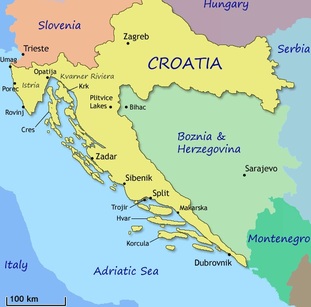 If I say Zagreb, what’s the first response that comes to your mind?
My answer? None of the above. In the past few years, Croatia's capital has transformed itself into one of the most delightful cities in Europe — and one that’s still refreshingly tourist-free. It’s filled with great eateries, lush parks, and the kind of stylish clothing stores that seriously challenge my policy of traveling with minimalist luggage. “You see all these coffee places and small shops,” said my local friend Doris, gesturing to the charming boutiques and cafés around us. “They are all new in the last five years.” Perhaps the best part of Zagreb’s renaissance is the offbeat museum scene. Among the most innovative is the Museum of Broken Relationships, which displays keepsakes from grand passions that have gone down in flames. For example: The museum was, naturally, the result of a romance gone wrong. When local artists Olinka Vištica, and Dražen Grubišić called it quits, they wondered what people are supposed to do with love tokens from relationships now lying in ruins, stuff that’s too significant to throw away and too painful too keep around. Why not put these objects on display, they thought, along with their stories? The first, wildly successful traveling exhibition gave rise to museums in Zagreb and now Los Angeles; the show still goes on the road, and people around the world are invited to donate mementos and anecdotes. (If you’ve got a splitting-up story that deserves a wider audience, here are the contributor’s guidelines.) As an antidote to the angst of the exhibitions, the gift shop reminds us that breaking up may be hard to do, but it can also be funny as hell. “Oh look,” I said to Rich the next day. “There’s a Museum of Illusions. Let’s check that out.” To be perfectly honest, it turned out to be a bit cheesy and far from original, filled with well-worn optical tricks, such as holograms and op art. But some of it was good fun. In our rambles, Rich and I discovered parades, traditional dancers, and venerable second-hand book stores. The food and drink — from markets, dive bars, cafés, and street vendors —ranged from interesting-but-never-again (the house white in Bacchus Jazz Bar) to very good indeed (the sardines at Bistro Amfora). The best meal we had, hands down, was made by a local dentist named Lidija. She had just become EatWith’s first Zagreb host, and Rich and I were her inaugural guests. Joining us at table were her daughter Doris and long-time friend Mladen, who immediately produced a test tube of orange rakija (fruit brandy) and invited us to try it. From that first moment, the evening flowed forward, the conversation rolling around the table as easily as if we had been old friends. Dinner was served on Lidija’s balcony to take advantage of the unseasonable warm weather, known here, Mladen explained, as “old woman summer.” We began with viška pogača, bread topped with olive oil, onions, and anchovies. “The recipe comes from the island of Vis, in southern Croatia,” said Lidija. “Traditionally it is made with a second crust on top, but that is too much bread, I think.” A summer salad of tomato, cheese, and olives followed, and then Lidija brought out the main course, fresh skuša riba (mackerel) cooked to perfection, the fish dense yet flaky, surrounded with organic potatoes. The side dish was a vegetable nobody knew how to translate. “It’s like kale, but it’s not,” said Doris. One of the things I loved best about this dinner was that nobody reached for a phone to look it up; we were having way too much fun to bother with technical details like that. For dessert we had delicious rožata, a cross between flan and crème brûlée, topped with sour cherries soaked in rakija, accompanied by small, sweet purple grapes from Lidija’s garden. 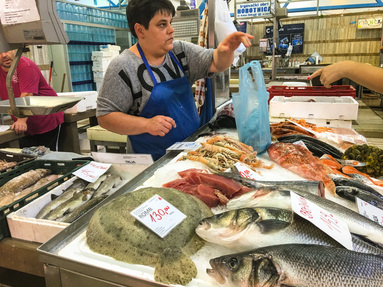 Fishmonger at Dolac Market, a great place to buy fresh skuša riba Fishmonger at Dolac Market, a great place to buy fresh skuša riba I don’t know quite what I expected from Zagreb, but it wasn’t this dazzling kaleidoscope of good fun and good food. Our last night in town, Lidija, Mladen, and Doris took us out to some of their favorite bars for beer and rakija. As we walked through the velvety night, Mladen was explaining some point of local history that “could only happen here in the Balkans.” Wait, what? We were in the Balkans? Somehow I hadn’t tracked that geographical detail at all. Why did it matter? Well, as long-term readers of this blog know, our original concept for the trip was a Balkans-to-Baltics tour lasting five months. When our plans were derailed by family issues requiring our presence in the US, we shortened the trip to three months, started in the north, and accepted the disappointing fact that we wouldn’t have time to work our way as far south as the Balkans. And yet we had. It was a wonderful, gobsmacking realization. So that’s Zagreb for you: a place that’s full of surprises and has a knack for turning tragedy into triumph and strangers into friends. Sure, you can zip through it on your way elsewhere and never give it a second glance. But why would you want to? Days on the road: 81 Distance covered: 4625 km / 2874 miles Highlights have included zany Amsterdam, the German city of Lübeck on the edge of the Baltic Sea, the Stockholm disaster, the new foodie mecca of Helsinki, Finland, futuristic Estonia, and a kookie visit to Riga, Latvia. We headed south to Šiauliai, Lithuania, where history — and great chocolate — were made. Vilnius — and the tiny Republic of Užupis— taught me about miracles; I learned about devils in southern Lithuania and northern Poland. In Warsaw, we learned that nothing is what it seems. We rode the midnight bus Lviv, Ukraine, and after many adventures there, we moved on to Hungary, with a brief stopover in Budapest and a somewhat too-peaceful rest stop in Pécs. We've just left Zagreb, Croatia for Ljubljana, the capital of Slovenia. To follow our adventures as they unfold, subscribe to my blog, like my Facebook page, and keep checking the map of our journey. |
This blog is a promotion-free zone.
As my regular readers know, I never get free or discounted goods or services for mentioning anything on this blog (or anywhere else). I only write about things I find interesting and/or useful. I'm an American travel writer living in California and Seville, Spain. I travel the world seeking eccentric people, quirky places, and outrageously delicious food so I can have the fun of writing about them here.
My current project is OUT TO LUNCH IN SAN FRANCISCO. Don't miss out! SIGN UP HERE to be notified when I publish new posts. Planning a trip?
Use the search box below to find out about other places I've written about. Winner of the 2023 Firebird Book Award for Travel
#1 Amazon Bestseller in Tourist Destinations, Travel Tips, Gastronomy Essays, and Senior Travel
BLOG ARCHIVES
July 2024
CATEGORIES
All
|
